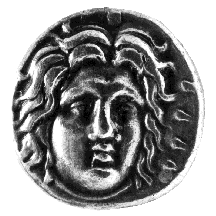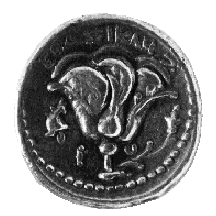



(36) Rhodes (Greece) - AR didrachm, c. 333-304 B.C., 6.76
g. (inv. 91.085).
Obverse: Facing radiate head of Helios.
Reverse: Rose; in l. field, helmet; on either side of flower,
![]() : abbreviation for Rhodes;
: abbreviation for Rhodes; ![]() :
Erasikles, name of magistrate.
:
Erasikles, name of magistrate.
Provenance: Edward Gans, 1959.
Bibliography: C.M. Kraay, Greek Coins (New York
1966).
In the late fifth century B.C. the three independent cities of the island
of Rhodes, Lindos, Kamiros and Ialysos, united and founded a new capital
city, also named Rhodes. The coins of the new capital depicted the island's
main deity, the sun god Helios, on the obverse and a rose (in Greek rhodos),
a play on the name Rhodes, on the reverse.
According to legend, when Zeus forgot Helios as he was dividing the islands
among the gods, Helios said that he would take an island then rising from
the sea, Rhodes. His children with the nymph Rhodos became rulers of the
island, and the island's three cities were named after them. The cult of
Helios was an important one in Rhodes. The island's most famous monument,
the Colossos, was a bronze statue of Helios by Chares of Lindos, a pupil
of Lysippos. It stood some 32 m. high at the entrance to the city's harbour.
The facing head of Helios on Rhodian coins was probably inspired by Kimon's
famous facing head of the nymph Arethusa on Syracusan coins (see no. 17).
In both heads the hair spreads outward, in Helios changing into the rays
of the sun.
The coins of Rhodes had an interesting life in the Middle Ages. At that
time it was thought that the head of Helios was the head of Christ, that
the rose was the rose of Sharon, and that the coins were the thirty pieces
of silver paid to Judas.
R.H.L.



All contents copyright (c) 1996.
Lawrence University
All rights reserved.